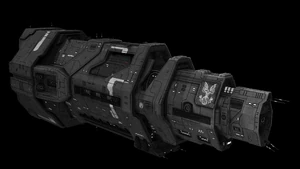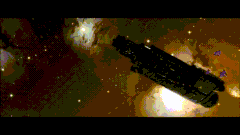| This fanfiction article, Halcyon-class light cruiser, was written by Sev40. Please do not edit this fiction without the writer's permission. |
| This article, Halcyon-class light cruiser, was written by Sev40, but may be used freely by other users even without the author's explicit permission. |
| This is a fanon expansion of a canon element. To see the original canon article, follow the link to Halopedia: Halcyon-class light cruiser. |
| The author, Sev40 urges and gives permission for any user who references this unit or vessel, Halcyon-class light cruiser, to add their article to the "Known" list below. |
| |||||||||||||||||||||||||||||||||||||||||||||||||
| [Source] | |||||||||||||||||||||||||||||||||||||||||||||||||
- "A dozen Covenant superior battleships against a single Halcyon-class cruiser. Given those odds, I'm content with three...make that four kills."
- ―Cortana, during the Battle of Installation 04.
The Halcyon-class light cruiser (hull classification symbol: C) was a distinguished class of light cruisers which saw service in the Insurrection and later the Human-Covenant War. Originally shot down by the UNSC on the grounds for its lack of tactical viability, the Halcyon would be mocked for being the slowest, most underarmed and underpowered cruiser developed in the twenty-sixth century. Notable only for its unusually-strong honeycomb superstructure, the Halcyon's advantages would prove too limiting and it would be quickly replaced by its successor, the Marathon-class heavy cruiser.
The Halcyon would embark on a limited production run, with only fifty ever being built. Although some would be hastily retrofitted with more weapons and hangars in an attempt to increase their combat viability, by 2521 the entire class was reassigned into reserve fleets. They would be saved from certain scrapping with the arrival of the Covenant, with their complicated superstructure actually allowing them to survive far longer than their replacements against their quarry's exotic weaponry. As a result, they were pulled out of the dockyards and refitted up to modern standards, and proved to be one of the most powerful ships at the UNSC's disposal. However, even these updated cruisers would take horrendous losses, ensuring that each Halcyon was deployed sparingly. Nevertheless, the class would become an icon symbolising durability, and would inspire SinoViet Heavy Machinery to base the aesthetic appearance of the Autumn-class cruisers on these outdated vessels.
Layout
Specifications
Propulsion
Armament
Armour and Superstructure
Widely regarded as their sole meaning for existence, these cruisers became renowned for their durability. A sophisticated ecosystem of supporting skeletons, a mix of internal and external plating, and emergency repair systems work together to expertly hold the ship together while under fire - a configuration that continued to remain unique even decades after the Halcyon's launch. Each component alone is capable of mitigating damage with greater efficiency than any other competitor on the market, but are combined to increase the tolerance so much that they exceeded the structural guidelines the Navy placed upon contemporary battleships and heavy carriers.

|
| The novel technique of honeycomb bracings placed throughout its hull offered unparalleled strength, despite intruding on the ship's other needs. |
Originally unique to this model of cruiser, the first eleven ships were host to a powerful series of interconnected supports arranged in an octagonal pattern. Developed by Dr. Robert McLees himself, this honeycomb structure uses a combination of hyperdense diamond-Tungsten composite
Reactor
Countermeasures
Variants
With the unexpectedly low demand found in the Halcyon-class, RMC took to invest in a number of potential hull upgrades to the class, and experimented in an effort to salvage the insane amount of money they lost developing them. Each of the Halcyon's variants added an extensive amount of superstructure to the class, with most of it being fitted over the base hull in case the UNSC contracted them to upgrade them to a set standard.
Aegaeon-class carrier

|
| Longer than the base model, the Aegaeon-class heavy carrier's capabilities resemble that of the later Epoch-class heavy carrier. |
- "Keep pressing your attack squadron leader - this is nothing more than a Tuesday for us."
- ―Lieutenant Commander Tyson Parker, as his ship is suffering from damage across thirty decks.
Larger than even the later Autumn-class, the Aegaeon-class carrier is designed around an elongated first flight Halcyon hull, hollowed out to allow it to carry an extended amount of space fighters and material. Produced only in limited numbers, these carriers, like the ships they are built from, never saw extended production. However, the ships that were built went on to earn a mythical status within the fleets they served in.
Measuring nearly than 1,800 metres from fore to aft, the Aegaeon-class still features the same dense honeycomb superstructure which made the base design so durable. However, it does not retain it throughout its entire frame, and incorporated minor concessions in order to make the construction of a larger warship cheaper and thus more feasible. The defensive armaments have been improved and brought up to standards. It still retains a single MAC, but this has been upgraded to a heavier calibre and now runs almost half the length of the carrier, with thirty pods of Archer missiles and dozens of point-defence guns added. While this is nowhere near as powerful as a ship of its size should be, it can now adequately defend itself against more capable threats. Its reactors and engines are larger, although it is still considered slow for its size.
Ares-class cruiser

|
Operational History
Ships of the Line
| Name | Hull Classification Symbol | Commissioned | Destroyed | Notes | ||
Commissioned between 2510 and 2511, the first block of Halcyons incorporated a wide range of innovations, including a rigid honeycomb superstructure and an impressive command suite backed up by a reliable communications package. However, their poor weapons for their size and complex design meant that only eleven were built. | ||||||
|---|---|---|---|---|---|---|
| UNSC Halcyon | C-677 | 4/2/2510 | Lead ship for the class. | |||
| UNSC Belfort | C-685 | 16/5/2510 | 2526 | Destroyed during the Battle of New Gettysburg. | ||
| UNSC Pillar of Autumn II | C-691 | 30/6/2510 | N/A | Commissioned as the UNSC Duties and Desires, initially decommissioned due to outstanding performance issues. Requisitioned by ONI and rechristened the UNSC Dawn Under Heaven, it served as a secret mobile research laboratory and deep-space resupply station. After the disastrous Skirmish of ARC-IX, it was released by ONI to be rebuilt under the Autumn-class standards and was given its modern name. | ||
| UNSC Red Wall | C-699 | 21/7/2510 | N/A | Participated during the Battle of New Gettysburg. | ||
| UNSC Illinois | C-703 | 8/10/2510 | 2526 | Flagship of Battlegroup Yankee-7, destroyed during the Battle of New Gettysburg. | ||
| UNSC Toulouse | C-708 | 8/8/2510 | Unknown | Engaged an armada of CCS-class battlecruisers over an unidentified Forerunner installation. Likely destroyed. | ||
| UNSC Pillar of Autumn | C-709 | 1/12/2510 | 22/9/2552 | Upgraded to be part of Operation: RED FLAG, sacrificed itself to destroy Installation 04. Would lay the foundations for the Autumn-class heavy cruiser. | ||
| UNSC Persian Gate | C-715 | 12/1/2511 | Participated in the Battle of Alpah Corvi II. | |||
| UNSC Roman Blue | C-717 | 26/2/2511 | 2535 | First command for Terrence Hood, participated in the Battle of Arcadia, crashed-landed on Eiro during the Siege of Chi Rho. | ||
| UNSC Gibraltar | C-748 | 13/5/2511 | 2526 | Destroyed during the Battle of New Gettysburg. | ||
| UNSC Ironside | C-767 | 16/5/2511 | 2531 | Captained by George Elliot, participated in the Battle of New Gettysburg. | ||
|
Ordered in 2510, Block II was composed of thirty-seven ships that were drastically modified to minimise cost and difficulty of construction at the cost of durability. As they were completely outperformed by the Marathon-class in all areas, they would be mothballed before their first decade of service was over. | ||||||
| UNSC Minneapolis | C-711 | 7/9/2512 | 2526 | Destroyed during the Battle of New Gettysburg. | ||
| UNSC Constantinople | C-718 | 31/3/2513 | 1/3/2526 | Destroyed by a Covenant super-destroyer over Harvest. | ||
| UNSC Extinction of Fear | C-720 | 2513 | 17/11/2552 | Destroyed during Battle for Earth. | ||
| UNSC Maginot Line | C-726 | 2513 | N/A | |||
| UNSC Prince Arslan | C-747 | 2514 | 2544 | Ambushed alongside Destroyer Squadron Brawler after fleeing the Battle of Miridem. Destroyed after ramming the ORA-class interdictor cruiser Protean Soul. | ||
| UNSC Båstad | C-792 | 2514 | N/A | Participated in the Battle of Psi Serpentis and the Fall of Reach. Heavily damaged during Battle for Earth, later refitted to Autumn-class heavy cruiser. | ||
| UNSC Macarthur | C-799 | 9/9/2514 | 2526 | Destroyed during the Battle of New Gettysburg. | ||
| UNSC Last Unto Dusk | C-801 | N/A | Commanded by Bartholomew Manfred, reffited to an expeditionary Autumn-class heavy cruiser after the war. | |||
| UNSC Hephaestus | C- | 2552 | Led the Battlegroup Hephaestus during the Battle of Circumstance, destroyed during the same engagement. | |||
| UNSC Way to Home | C- | N/A | Formerly captained Lin Zhi assigned to the Sixth Fleet. | |||
|
Resulting in only two warships before it was cancelled in 2539, the third block would've resulted in a massive overhaul of the class, with the main improvements being found in its offensive and defensive subsystems. Despite this, nearly all surviving vessels would be upgraded to these specifications, vastly improving their fighting capabilities. | ||||||
| UNSC Fortitude | C-753 | 12/7/2539 | Attacked by Thel 'Vadamee's Fleet of Particular Justice while pursuing a CCS-class battlecruiser alongside its twin sister-ship the UNSC Enterprise and a Paris-class heavy frigate. | |||
| UNSC Enterprise | C-754 | 2539 | Attacked by Thel 'Vadamee's Fleet of Particular Justice while pursuing a CCS-class battlecruiser alongside its twin sister-ship the UNSC Fortitude and a Paris-class heavy frigate. | |||
| UNSC Aegaeon | Lead ship of the class. | |||||
| UNSC Ares | Lead ship of the class. | |||||
UNSC Remarks
Gallery
Notes






